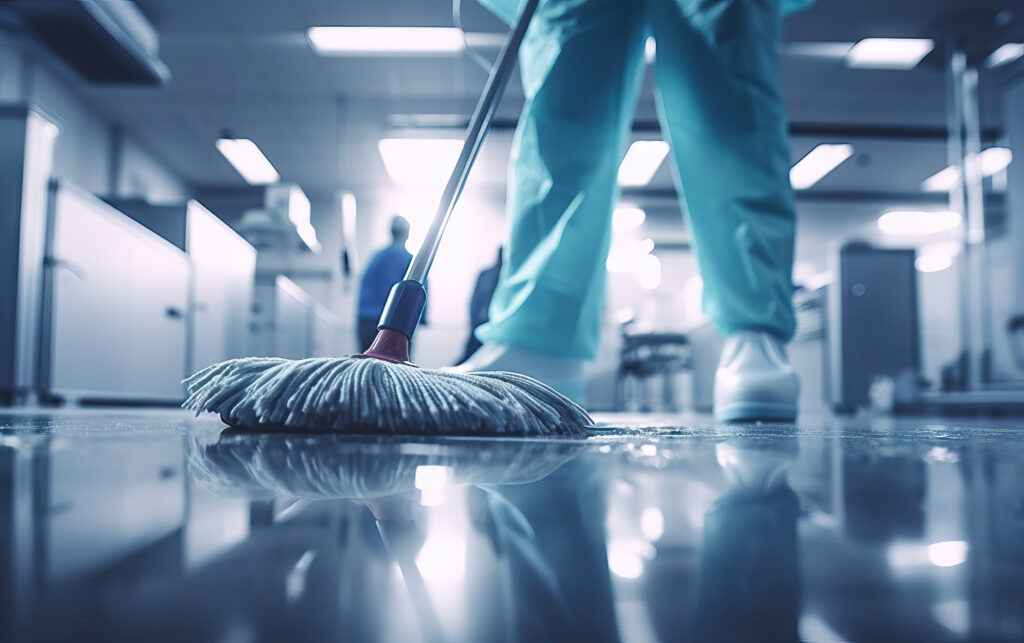The morning light filters through half-drawn blinds as I run my palm across the surface of my mother’s hospital tray table.
Three weeks into her unexpected stay, I’ve developed new rituals.
This daily inspection isn’t conscious anxiety—it’s become instinct.
Yesterday, a young woman with tired eyes and gentle hands meticulously wiped down every surface in this room, including the underside of this same table.
She caught me watching and said something that shifted my perspective entirely: “I’m not just cleaning. I’m preparing the space for healing.”
Her words have lingered with me.
In that moment, I realized medical cleaning transcends the mechanical removal of pathogens—it’s an essential, if overlooked, healing art.

Disinfecting A Medical Office
The Unseen Architecture of Recovery
Healthcare environments speak to us through all senses, creating either harmony or discord in our healing journey. The language they use isn’t just visual or auditory—it’s microscopic.
What Our Bodies Read Between the Lines
Our bodies constantly scan our surroundings, making countless unconscious assessments that influence our physiological state. The immune system, already taxed during illness, remains hypervigilant in environments that signal potential threats.
I witnessed this with my mother. During her first week, she was placed in an older wing where despite technically meeting cleanliness standards, the worn grout lines, subtle residual odors, and aging surfaces created a persistent unease she couldn’t articulate. After transfer to a recently renovated section with meticulous cleaning protocols, her sleep improved dramatically within 48 hours. Nothing in her medical treatment had changed—only the environment’s subtle messaging to her nervous system.
When surfaces, air quality, and even the hidden corners communicate safety, our bodies divert precious energy from defensive vigilance to the complex work of healing.
The Compassionate Chemistry
Medical cleaning exists at a fascinating crossroads where chemistry meets compassion. Modern approaches balance microbial management with human-centered care—a delicate equation with profound implications.
The cleaning supervisor who trained the young woman caring for my mother’s room shared their department’s philosophy: “We’re not just applying disinfectants. We’re applying peace of mind.”
This philosophy manifests in thoughtful protocols that consider both pathogen profiles and human experience—like scheduling intensive cleaning procedures around patients’ rest periods, or selecting products that effectively neutralize infectious agents without triggering respiratory sensitivity.
Reimagining the Cleaning Relationship
The relationship between medical spaces, those who clean them, and those who heal within them deserves reconsideration.
From Invisible to Integral
In many healthcare settings, cleaning staff operate on the periphery of the care team—essential yet somehow separate from the healing narrative. Progressive institutions are challenging this paradigm.
At the rehabilitation center where my colleague recovered from spinal surgery, cleaning professionals attend selected patient care meetings and contribute observations that clinical staff might miss. His primary cleaner noticed he seemed more uncomfortable on days when window glare created subtle eye strain and suggested adjusting cleaning times to allow for blind repositioning. This small intervention improved his pain management significantly.
Such integration acknowledges that those who maintain healing spaces hold valuable perspective precisely because their work touches every aspect of the environment.
The Choreography of Care
The most thoughtful medical cleaning isn’t random disinfection—it’s choreographed care responding to the unique rhythms of each healing space.
High-touch surfaces receive attention with frequency mapped to human behavior patterns. Special attention surrounds vulnerable moments—cleaning intensifies methodically before and after procedures. Environmental services teams increasingly time their work to complement rather than interrupt the healing cadence of each department.
Crafting Environments That Actively Heal
The future of healthcare environments lies not in sterility alone but in spaces intentionally designed to participate in the healing process.
Beyond Absence to Presence
The evolution from merely eliminating pathogens to creating positively healing environments represents a profound shift. This approach considers not just what should be removed from healing spaces, but what should be present.
Surface materials selected for both cleanability and warm tactile qualities. Cleaning solutions that leave behind subtle molecular benefits rather than chemical residues. Lighting systems designed to facilitate thorough cleaning while supporting natural circadian rhythms.
The Human Element Remains Irreplaceable
Despite technological advances in disinfection—UV robots, electrostatic systems, and antimicrobial surfaces—the human element of medical cleaning remains irreplaceable.
The cleaner who instinctively knows when to work silently and when a brief, genuine interaction might lift a patient’s spirits. The environmental services director who trains staff to notice subtle signs of decline in long-term patients. The overnight team quietly maintaining spaces while healing sleep occurs.
These human touches transform mere cleaning into an active component of the care ecosystem.
The young woman who cleaned my mother’s room wasn’t just removing potential pathogens. She was creating the conditions where healing became more possible. In healthcare environments, cleanliness isn’t separate from treatment—it’s where treatment begins.

